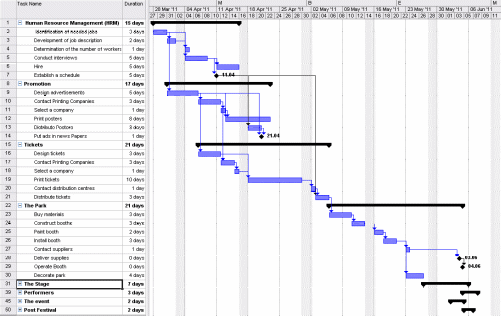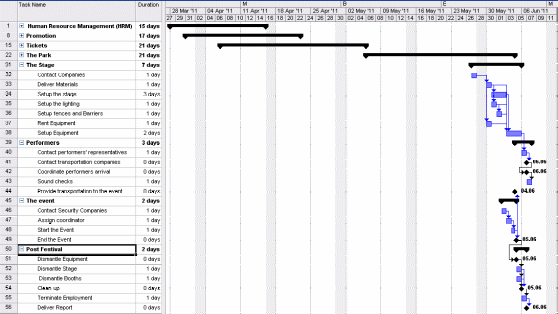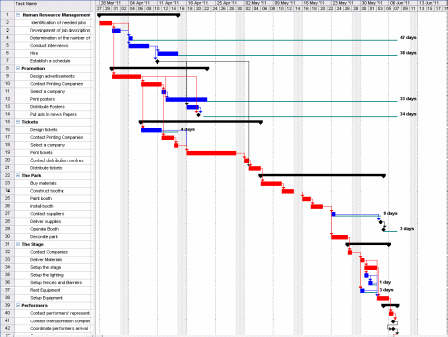Executive Summary
A one-day music festival is arranged to take place in Greenwich Park. The project will start on March 28, 2011, and end on June 5, 2011, with the festival taking place on June 4, 2011. The estimated number of attendees is 10,000 people. The current report outlines the details of the project, the tasks, stakeholders, division of roles and responsibilities, and potential risks of the project.
Stakeholders
The stakeholders are individuals or organizations involved in the project, and/or those whose interests are directly influenced by the project’s success and completion (PMI Standards Committee and Project Management Institute, 1996). The key stakeholders in a project of planning a one-day music festival in Greenwich Park are the following:
- UK music promoter – the sponsor of the project.
- Team A – a project management team responsible for the planning process for the music festival.
- Subcontractors – various subcontractors who will be hired during the duration of the project to perform the task involved.
- Customers – the attendees of the festival.
Business Needs
The initiation of the project is based on the business need of the promoter, where the authorization of the project is driven by the tickets’ sales revenues, which are estimated at the maximum capacity of the venue -10,000 people, and the determined ticket price – £ 40. Other sources of expected revenues include advertisers and sponsors.
Scope Statement
Project Justification
The project is concerned with planning a one-day Music Festival that will take place on the 4th of June 2011, in Greenwich Park. The project is concerned with all steps leading to the festival apart from performers’ contracts and accommodations. Namely, the project will help to prepare areas, such as the development of event site, development of event infrastructure, food and beverages operations, transportation, and security.
The deliverables of the project can be seen through the following:
- Setting up the venue.
- Setting up the stage.
- Sold ticket.
- Promotion materials.
- Human Resource Management (HRM) –staff ready for the project.
- Performers.
- The event.
- Post-festival Service.
Specific Project Objectives
The duration of the project is 70 days – 10 weeks, starting from Monday, 28th of MARCH, 2011, and ending on 5th of June, 2001, the day after the festival, for cleaning, demounting, and de-installation of equipment. The set date for the festival is Saturday, the 5th of June, 2011.
Work-Breakdown Structure (WBS)
The Work Breakdown Structure (WBS) for the event can be seen as follows:
- Human Resource Management (HRM) (Walton, 2010)
- Identification of needed jobs.
- Development of job description.
- Determination of the number of workers needed.
- Conduct interviews.
- Hire.
- Establish a schedule.
- Promotion
- Design advertisements.
- Contact Printing Companies.
- Select a company.
- Print posters.
- Distribute Posters.
- Put ads in news Papers.
- Tickets
- Design tickets.
- Contact Printing Companies.
- Select a company.
- Print tickets.
- Contact distribution centres.
- Distribute tickets.
- The Park
- Buy materials.
- Construct booths.
- Paint booth.
- Install booth.
- Contact suppliers.
- Deliver supplies.
- Operate Booth.
- Decorate park.
- The Stage
- Contact Companies.
- Deliver Materials.
- Set up the stage.
- Set up the lighting.
- Setup fences and Barriers.
- Rent Equipment.
- Setup Equipment.
- Performers
- Contact performers’ representatives.
- Contact transportation companies.
- Coordinate performers arrival.
- Sound checks.
- Provide transportation to the event.
- The event
- Contact Security Companies.
- Assign coordinator.
- Start the Event.
- End the Event.
- Post Festival
- Dismantle Equipment.
- Dismantle Stage.
- Dismantle Booths.
- Clean-up.
- Terminate Employment.
- Deliver Report.



Assumptions
It should be noted that cells in which 0 days are displayed imply that the tasks will start and end on the same day. Accordingly, several assumptions will be made in outlining the relationship between tasks. The first one is related to the start of the project, in which a constraint is set for the first tasks of the project to start no earlier than 28th of March, 2011. The second assumption is related to the dependencies between tasks. All tasks are dependent on each except for “Start the Event” tasks, which start is set for the 4th of June date. Finally, except for the 4th of June, i.e. the day of the Festival, and the day that follows, i.e. the 5th of June, all working weeks are 5 days, where the task that consists of 3 days and starts on Friday transfers to the start of the next week.
Roles and Responsibilities
The tasks and the responsibility will be developed with consideration to the number of team members assigned to the project. The team consists of four members and a team director. For convenience team members will be numbered through the process of outlining their roles and responsibilities. The roles and the responsibilities of the project team and the roles and responsibilities of the client team are outlined in the following table:
Project Communication and Control
The role of the team can be seen in planning activities and effective coordination of the tasks and their control. In that regard, effective communication is an essential aspect of the project. The dissemination of information and the total control of the project is the responsibility of the project director. Any changes in the tasks their activities, schedules, and resources e approved through the Project’s director through established procedures and documentation (Gido, 2011). Additionally, the director will hold responsibility for the final report delivered after the project’s completion.
Procurement Management
In managing subcontractors, the kind of purchases made will determine the type of contract used. There are several types of purchases and arrangements during the project, which can be divided into three types:
- Services.
- Materials.
- Labour.
The services include printing the promotional materials, and the services of security and transport companies. For transport and security companies’ unit price contacts will be arranged. Unit price contracts can be defined as contracts in which the seller of the service or the product is paid a pre-set amount per unit of service (PMI Standards Committee and Project Management Institute, 1996).
In this case, the unit of service is an hour for both the transport and the security. The unit of services is attached to a particular product, per car, or security officer in this case. Several companies will be contacted before the implantation of the project, where the company with the lowest bid will be considered. A fixed price or a lump sum contract might be arranged with the security company for arranging the security of the park during the day of the festival. In that regard, the number of security officers required, or the hours of work might be ignored, with the focus being on the final product which is securing the park and the venue during the festival for as long as the festival takes place. Lump-sum contracts can be defined as contracts that involve a fixed “price for a well-defined product” (PMI Standards Committee and Project Management Institute, 1996). The latter can be considered as a form of outsourcing activities (Wallace, 2007). Lump-sum contracts can be arranged for cleaning the park after the festival as well, where cleaning the park can be defined as the product in question, for which a fixed price will be paid.
The materials for the project can be purchased or rented for the duration of their exploitation. The purchased materials those required for the construction of food and beverages booths, their painting, and the decoration of the park. Accordingly, the latter include the supplies needed for booths’ operation, i.e. the food and the beverages. In this case, unit price contracts will be also used, where all of the supplies can be measured in units and the products can be quantified easily.
The labour part of the project includes all staff that had to be employed during the various parts of the project and with various durations. The tasks include designing posters and tickets, distribution of posters and tickets, carpenter tasks (booth constructions), painters, workers (decorations, setting fences, setting the stage, dismantling the stage, etc). The type of contract suitable for such a purpose is a cost-reimbursable contract. Such contracts can be defined as those which involve “payment (reimbursement) to the seller for its actual costs. Additionally, the salaries of the team working on the project will be also classified as cost reimbursable contracts, namely in the category of direct costs.
Risk Management
The risk management plan of the project will identify the main risks in the project, their level, the resources assigned, and a contingency plan in case the risk shall occur. As every project faces a range, responding to those risks is a matter of planning, i.e. acknowledging the existence of those risks and planning how they can be mitigated (Heerkens, 2005). Classifying the response to the risks, it can be stated that the response mainly focuses on risk-mitigating, through either reducing the probability of occurrence or reducing the risk event value, i.e. insurance. The risks identified in this project along with their contingency plans can be seen through the following table:
Reference List
GIDO, J. 2011. Successful project management, Cincinnati, OH, South-Western Pub.
HEERKENS, G. 2005. Project management: 24 lessons to help you master any project, New York, McGraw-Hill.
PMI STANDARDS COMMITTEE & PROJECT MANAGEMENT INSTITUTE 1996. A Guide to the project management body of knowledge, Project Management Institute.
SILVERS, J. R. 2004. Professional event coordination, Hoboken, N.J., Wiley.
WALLACE, S. 2007. The ePMbook. Simon Wallace. Web.
WALTON, K. 2010. Article Based on WBS structure. Project Management for Festivals. Web.